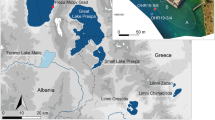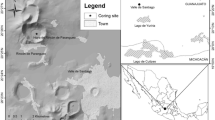Abstract
Palynological studies on late Quaternary lake sediments from the region of the Amazon estuary, 100 km north-east of Belém, Pará State, Brazil, enable reconstruction of lowland Amazonian rain forest during the Late-glacial and Holocene periods. Late-glacial forests included populations of Podocarpus which suggests a distinct climatic cooling. Ilex was abundant in the early Holocene. Records of the mangrove taxon, Rhizophora, indicate rapid Atlantic sea-level rise in the beginning of the Holocene. High charcoal representation may reflect the first arrival of Amerindians in the Amazon coastal area, probably about 10 800 B.P.
Similar content being viewed by others
References
Absy ML (1979) A palynological study of Holocene sediments in the Amazon Basin. Doctoral thesis, University of Amsterdam
Absy ML, Cleef AM, Fournier M, Martin L, Servant M, Sifeddine A, Ferreira da Silva M, Soubies F, Suguio K, Turcq B, Hammen T van der (1991) Mise en évidence de quatre phases d'ouverture de la forêt dense dans le sud-est de l'Amazonie au cours des 60 000 derniéres anneés. Premiére comparaison avec dáutres régions tropicales. C R Acad Sci Paris 312: Série II, 673–678
Behling H (1995) Investigations into the Late Pleistocene and Holocene history of vegetation and climate in Santa Catarina (S Brazil). Veget Hist Archaeobot 4: 127–152
Beug HJ (1957) Untersuchungen zur spätglazialen und frühpostglazialen Floren- und Vegetationsgeschichte einiger Mittelgebirge (Fichtelgebirge, Harz und Rhön). Flora 145: 167–211
Bush, MB (1994) Amazonian speciation: a necessarily complex model. J Biogeogr 21: 5–17
Bush MB, Colinvaux PA, Wiemann MC, Piperno DR, Liu KB (1990) Late Pleistocene temperature depression and vegetation change in Ecuadorian Amazonia. Quat Res 34: 330–345
Bush MB, Piperno DR, Colinvaux PA, Krissek L, De Oliveira PE, Miller MC (1992) A 14,300 year paleoecological profile of a lowland tropical lake in Panama. Ecol Monogr 62: 251–275
Colinvaux PA (1993) Pleistocene biogeography and diversity in tropical forests of South America. In: Goldblatt P (ed) Biological relationships between Africa and South America. Yale University Press, New Haven, pp 473–499
Gentry AH (1993) Woody plants of northwest South America. Conservation International, Washington DC
Haffer J (1969) Speciation in Amazonian forest birds. Science 165: 131–137
Hammmen T van der (1963) A palynological study on the Quaternary of British Guiana. Leidse Geol Meded 29: 126–68
Hammmen T van der, Absy ML (1994) Amazonia during the last glacial. Palaeogeogr Palaeoclimatol Palaeoecol 109: 247–261
Klein RM (1980) Ecologia da flora e vegetação do Vale do Itajaí. (Continuação). Sellowia 32: 165–389
Liu KB, Colinvaux PA (1985) Forest changes in the Amazon basin during the last glacial maximum. Nature 318: 556–557
Mainieri C, Pires JM (1973) O gênero Podocarpus no Brazil. Silvi Sao Paulo 8: 1–24
Meggers BJ, Evans C (1957) Archeological investigations at the mouth of the Amazon. Smithson Inst Wash Bull 167: 1–664
Nimer E (1989) Climatologia do Brasil. Fundaçãõn Brasilero de Geografia e Estatística, Rio de Janeiro
Pires JM, Prance GT (1985) The vegetation types of the Brazilian Amazon. In: Prance GT, Lovejoy TE (eds) Key environments Amazonia. Pergamon Press, Oxford, pp 109–149
Rogers DJ, Appan SG (1973) Flora Neotropica. Monograph No. 13, Manihot (Euphorbiaceae). New York, Hafner Press
Roosevelt AC (1991) Moundbuilders of the Amazon: geophysical archaeology on Marajo Island, Brazil. Academic Press, San Diego
Roosevelt AC, Lima da Costa M, Lopes Machado C, Michab M, Mercier N, Valladas H, Feathers J, Barnett W, Imazio da Silveira M, Hederson A, Sliva B, Chernoff B, Reese DS, Holman JA, Toth N, Schick K (1996) Paleoindian cave dwellers in the Amazon: the peopling of the Americas. Science 272: 373–384
Stute M, Forster M Frischkorn H, Serejo A, Clark JF, Schlosser P, Broecker WS, Bonani G (1995) Cooling of tropical Brazil (5°C) during the last glacial maximum. Science 269: 379–383
Torres-Romero JH (1988) Flora de Colombia. 5. Podocarpaceae. Editoriales de la Imprenta National, Bogotá
Urrego LE (1991) Sucesión Holocénica de un Bosque de Mauritia flexuosa L. en el Valle del Río Cacuetá (Amazonia Colombiana). Colomb Amazonica 5: 99–118
Whitemore TC, Prance GT (1987) Biogeography and Quaternary history in tropical America. Oxford University Press, Oxford
Wijimstra TA (1971) The palynology of the Guiana coastal basin. Doctoral thesis, University of Amsterdam
Woodwell GM, Hobbie JE, Houghtion RA, Melillo JM, Moore B, Peterson BJ, Shaver GR (1983) Global deforestation: contribution to atmospheric carbon dioxide. Science 22: 1081–1086
Author information
Authors and Affiliations
Rights and permissions
About this article
Cite this article
Behling, H. First report on new evidence for the occurrence of Podocarpus and possible human presence at the mouth of the Amazon during the Late-glacial. Veget Hist Archaebot 5, 241–246 (1996). https://doi.org/10.1007/BF00217501
Received:
Accepted:
Issue Date:
DOI: https://doi.org/10.1007/BF00217501




